Parallel Processing
-
- NATO employs MUSCLE Memory to Find Mines Marine Technology, Jul 2019 #16
Underwater vehicles communicate, make decisions, and work as a team
The NATO Center for Maritime Research and Experimentation (CMRE) in La Spezia, Italy, is combining smarts and muscle to solve a complex warfighting challenge: finding and destroying mines in the murky waters of the littoral.CMRE has developed experimental unmanned vehicles for experimentation. Now it is evolving those vehicles to communicate and cooperate with each other, and to solve problems on their own.
According to CMRE’s director Dr. Catherine Warner, the center is trying to figure out where the unmanned systems best fit into operations, and doing the science to make them better, smarter, interoperable, autonomous, and more effective.
That’s a tall order, but the short answer is that CMRE’s scientists and engineers have adapted existing unmanned vehicles to work as a team.
CMRE developed JANUS, the NATO-standard protocol for communicating between underwater acoustic modems, and the Distributed and Decoupled (D2) Collaborative Autonomy Framework (D2CAF), so a network of unmanned underwater vehicles (UUVs) can talk to each other and work together. With D2CAF, the team of vehicles shares the processing among the different UUVs, and accompanying “gateway” unmanned surface vehicle (USV) if present, all connected by JANUS.At the center of the effort is CMRE’s General Dynamics Mission Systems Bluefin-21 unmanned underwater vehicle (UUV), which it has adapted as the Minehunting UUV for Shallow Water Covert Littoral Expeditions (MUSCLE) experimentation platform.
CMRE took advantage of the open architecture and modularity of the Bluefin -21 to equip it with a Thales synthetic aperture sonar (SAS), so it can look at and cover large areas quickly with high resolution. MUSCLE has onboard memory with a digital library of objects to help it conduct automatic target recognition (ATR). It can recognize and categorize objects in real time, and considers factors such as the quality of data and complexity of the area to determine the threat and level of certainty. It can then plan its mission to reduce that uncertainty. And with D2CAF, it can carry out those missions as a team.
For its experimentation, CMRE needed a system that’s robust, sturdy, and reliable.
“That’s exactly what MUSCLE is,” said Rob Been, deputy head of CMRE’s engineering. Division. “We’ve had the Bluefin-21 for quite a long time. And over the years, with the collaboration of Bluefin, we have made it more modular.”
 The MUSCLE and BLACK CAT UUVs on board NRV ALLIANCE prior to participation in GAMEX’17. (Photo: NATO CMRE)MUSCLE and BLACK CAT in GAMEX ’17 Exercise)
The MUSCLE and BLACK CAT UUVs on board NRV ALLIANCE prior to participation in GAMEX’17. (Photo: NATO CMRE)MUSCLE and BLACK CAT in GAMEX ’17 Exercise)Been said CMRE started off with a Bluefin with an integrated synthetic aperture sonar that had the ability to follow pre-programmed waypoints record data. “We would have to recover the vehicle and dump the data after each run. But with the collaboration between our scientists and engineers, you can see what it can do now. It has both CPUs and GPUs—central processing units and graphical processing units--so it can do a lot of parallel processing. We have enabled the Bluefin MUSCLE to see underwater in real-time, and thus by looking at the images, determine what to do next.”
Been said MUSCLE can start off with a ‘radiator’ search pattern, and depending on the visibility and the performance of the senor, which is based on the environment at that time, it determines the spacing of the radiator pattern. “You don’t want to have gaps, so you need to optimize that. The advantage of having that data available and the ability to process that on board is that you can make those decisions in stride, so you can make sure that you don’t have gaps. When it sees something, it uses its underwater acoustic modem to send a message to the gateway buoy and the gateway buoy sends it back to the ship, and they can see the detections in real time. There’s automated target recognition software on board the vehicle so it can determine that it is this type of target, with a degree of probability. If it detects sand ripples, it can optimize its position relative to sand ripple to get a better look. With collaborative autonomy, it can also task smaller vehicles to go and inspect a series of detections, collecting video feeds, which in turn, also, can be fed back to the ship.”
Dr. Samatha Dugelay, program manager for autonomous naval mine countermeasures at CMRE said the center adapted another Bluefin-21 as a collaborative autonomy test bed—named Black CAT--to demonstrate D2CAF by having MUSCLE and Black CAT work together. MUSCLE has an acoustic Doppler current profiler that detects current direction and velocity, and can reprogram its search patterns to account for currents. Black CAT, which hosts a version of D2CAF and is used for reacquisition, is equipped with a Teledyne Blueview 900 forward-looking sonar (FLS), optical camera, Blueview 2.25MHz multi-beam 3D sonar, and ARIS camera. CMRE also has a pair of Konsgberg Hydroid REMUS 100 vehicles with sidescan sonar and multi-beam echosounder (MBES) for reacquisition, and an IQUA Robotics SPARUS UUV with ARIS for reacquisition and simulated neutralization.
If MUSCLE cannot communicate directly with one of its collaborating vehicles, it can use the gateway buoy on a USV such as CMRE’s LiquidRobotics WaveGlider, to relay messages from one submerged vehicle to another, or back to the host platform.
“They all can perform different tasks,” Dugelay said. “For example, MUSCLE goes out, conducts the wide area survey, and finds the detections. BlackCAT has an optical camera and a forward-looking multi-beam echosounder to conduct reacquisition of the target. So they are two similar Bluefin vehicles that have been adapted to do different things
“The analysis of what it has seen, and the determination about what needs to be done next by the group of vehicles, is done in-stride onboard the MUSCLE, said Dugelay. “MUSCLE can determine the risk that there may still be something there that it hasn’t found, and it can develop a compound risk map to either go back to further search an area, or deploy other vehicles, like the Black CAT, to look closer and reduce that risk.”
CMRE conducts in-water testing, and has integrated its systems into operational exercises like Greek ARIADNE Mine Countermeasure Experiment (GAMEX) and the Spanish and Italian Mine Countermeasures Exercises (MINEX).The center can also leverage its extensive modelling and simulation capabilities to evaluate the collaborative autonomous systems and concepts of operation in various and complex operating environments.
About the Author
Edward Lundquist is a retired U.S. Navy captain who write frequently for Marine Technology Reporter. He travelled to La Spezia, Italy to report this story. -
- NAVIGATION & COMMUNICATIONS EQUIPMENT Maritime Reporter, Mar 1991 #50
of satellite positioning with the features and convenience of a bright, seven-color graphic display. The built-in Koden GPS receiver features parallel processing of the signal data, which can increase reception by up to four hours a day over multiplexed systems. And it eliminates the delay built into
-
- NAVIGATION & COMMUNICATIONS Maritime Reporter, Mar 1992 #64
. (EMS), reports its GPS Chart Viewer can provide 10-foot accuracy with its differential receiver. The unit comes standard with a six-channel parallel processing receiver, with a 12-channel unit optional. Called the "navigation instrument of the 90s" by EMS, the GPS Chart Viewer also offers one of
-
 )
March 2024 - Marine Technology Reporter page: 44
)
March 2024 - Marine Technology Reporter page: 44NEW TECH OCEANOLOGY INTERNATIONAL 2024 Image courtesy Metron/Cellula Teledyne Marine acquires Valeport: Matt Quartley, MD, Valeport and Ole Søe-Pedersen, VP & Image courtesy Teledyne Marine GM Teledyne Marine announce the deal in London. Pictured (L-R): Cellula Robotics, President, Eric Jackson, Metron
-
 )
March 2024 - Marine Technology Reporter page: 43
)
March 2024 - Marine Technology Reporter page: 43Image courtesy Kongsberg Discovery Image courtesy Teledyne Marine New Products Teledyne Marine had its traditional mega-booth at Oi, busy start to ? nish. Image courtesy Greg Trauthwein offers quality sub-bottom pro? ling capability without the need tion of offshore windfarms. GeoPulse 2 introduces new
-
 )
March 2024 - Marine Technology Reporter page: 41
)
March 2024 - Marine Technology Reporter page: 41Image courtesy Outland Technology Image courtesy Exail Image courtesy Submaris and EvoLogics Vehicles The ROV-1500 from Outland Technology represents a leap forward in underwater robotics, a compact remotely operated vehicle (ROV) weighing in at less than 40 lbs (19kg) the ROV- 1500 is easy to transport
-
 )
March 2024 - Marine Technology Reporter page: 38
)
March 2024 - Marine Technology Reporter page: 38used the CBA to check the function of the right pro? le. a low-voltage cut-out (LVCO) to prevent over-discharge of a LiPo batteries can be ganged in parallel on a two-wire volt- LiPo battery by setting the CBA cut-out voltage 0.50vdc low- age bus, as was described in Lander Lab #5, “Lithium Polymer er
-
 )
March 2024 - Marine Technology Reporter page: 37
)
March 2024 - Marine Technology Reporter page: 37miscible barrier ? uid heavier than seawater (sg=1.026) and lighter than the battery electrolyte (sg=1.265). The original cell vent cap was screwed into the top of the riser pipe to vent the gases associated with charging. Wires were soldered to the lead (Pb) posts. The lead-acid battery was additionall
-
 )
March 2024 - Marine Technology Reporter page: 34
)
March 2024 - Marine Technology Reporter page: 34potential. A battery pack is the creased internal resistance. Consult the manufacturer’s data- assembly of batteries in series, to increase voltage, in parallel, sheet for the discharge graphs. to increase current capacity, or both. Many batteries have a self-discharge rate, which means There are two broad
-
 )
March 2024 - Marine Technology Reporter page: 32
)
March 2024 - Marine Technology Reporter page: 32FEATURE SEABED MINING by a sea? oor plume from its pilot collection system test. pact, nodule collection system that utilizes mechanical and The Metals Company recently signed a binding MoU with hydraulic technology. Paci? c Metals Corporation of Japan for a feasibility study on The company’s SMD
-
 )
March 2024 - Marine Technology Reporter page: 23
)
March 2024 - Marine Technology Reporter page: 23elatively inactive since 2014, the Hunga Tonga–Hunga Ha‘apai (HT-HH) submarine volcano began erupting on December 20, 2021, reaching peak intensity on January 15, 2022. This triggered tsunamis throughout the Pa- R ci? c, destroyed lives and infrastructure, and generated the largest explosion recorded
-
 )
March 2024 - Marine Technology Reporter page: 18
)
March 2024 - Marine Technology Reporter page: 18TECH FEATURE IMR There are also weaknesses in terms of accuracy because of FiGS Operations and Bene? ts signal noise and the ability to detect small ? eld gradients. In Conventional approaches to evaluating cathodic protection this process there is a risk that possible issues like coating (CP)
-
 )
March 2024 - Marine Technology Reporter page: 16
)
March 2024 - Marine Technology Reporter page: 16TECH FEATURE IMR Image courtesy FORCE Technology OPTIMIZING CATHODIC PROTECTION SURVEY USING NON-CONTACT SENSORS By Svenn Magen Wigen, FORCE Technology he principle behind sacri? cial anodes, which are water structures, reducing the need for frequent repairs and used to safeguard underwater pipelines
-
 )
March 2024 - Marine Technology Reporter page: 15
)
March 2024 - Marine Technology Reporter page: 15sensor options for longer mission periods. About the Author For glider users working in ? sheries and conservation, Shea Quinn is the Product Line Manager the Sentinel can run several high-energy passive and active of the Slocum Glider at Teledyne Webb acoustic sensors, on-board processing, and imaging
-
 )
March 2024 - Marine Technology Reporter page: 14
)
March 2024 - Marine Technology Reporter page: 14TECH FEATURE TELEDYNE SLOCUM GLIDERS to hold over 3.5 times as many lithium primary batteries as the the water column and its thrusters give it the ability to stay standard Slocum Glider, and to physically accommodate up to on track in strong currents or other dif? cult ocean condi- 8 different sensor
-
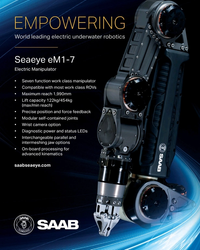 )
March 2024 - Marine Technology Reporter page: 3
)
March 2024 - Marine Technology Reporter page: 3Precise position and force feedback • Modular self-contained joints • Wrist camera option • Diagnostic power and status LEDs • Interchangeable parallel and intermeshing jaw options • On-board processing for advanced kinematics saabseaeye.com MTR #1 (1-17).indd 5 1/18/2024 9:04:54 A
-
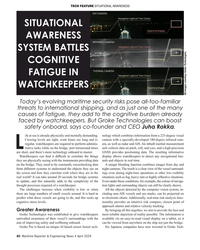 )
April 2024 - Maritime Reporter and Engineering News page: 40
)
April 2024 - Maritime Reporter and Engineering News page: 40TECH FEATURE SITUATIONAL AWARENESS SITUATIONAL AWARENESS SYSTEM BATTLES COGNITIVE FATIGUE IN WATCHKEEPERS All images courtesy Groke Technologies Today’s evolving maritime security risks pose all-too-familiar threats to international shipping, and as just one of the many causes of fatigue, they add
-
 )
April 2024 - Maritime Reporter and Engineering News page: 39
)
April 2024 - Maritime Reporter and Engineering News page: 39Tech Files Latest Products, Systems and Ship Designs “Wall Climbing Robot” Danish Pilot calls gets ClassNK Nod LEGO Model "A tribute build to a work life at sea" Image courtesy MOL, Sumitomo Heavy Industries lassNK granted its Innovation Endorse- Image courtesy Espen Andersen/DanPilot ment for
-
 )
April 2024 - Maritime Reporter and Engineering News page: 35
)
April 2024 - Maritime Reporter and Engineering News page: 35SIMULATION e have a close relationship with tech- Realism is prized beyond immersive, photo-realistic visu- nology, evidenced by, for example, als, and providers are introducing increasingly accurate func- the phones we are estimated to un- tionality. FORCE Technology’s upcoming DEN-Mark2 math- lock around
-
 )
April 2024 - Maritime Reporter and Engineering News page: 32
)
April 2024 - Maritime Reporter and Engineering News page: 32FEATURE A closeup of a blade installation process taken via drone. A blade handling system is apparent (in yellow). Images courtesy of Mammoet requirement for the development of these cranes, particularly ling area. This would result in a major time and fuel saving. in ? oating offshore wind,” says
-
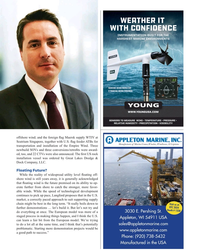 )
April 2024 - Maritime Reporter and Engineering News page: 23
)
April 2024 - Maritime Reporter and Engineering News page: 23offshore wind; and the foreign ? ag Maersk supply WTIV at Seatrium Singapore, together with U.S. ? ag feeder ATBs for transportation and installation of the Empire Wind. Three newbuild SOVs and three conversions/retro? ts were award- ed, too, and 22 CTVs were also announced. The ? rst US rock installa
-
 )
April 2024 - Maritime Reporter and Engineering News page: 15
)
April 2024 - Maritime Reporter and Engineering News page: 15hydro-acoustic design of a propulsor that delays cavitation meets its underwater noise limits. This will require specialized inception and cavitating area. The third approach should be test sites or specialized mobile underwater testing equipment. isolation mounting of a vibro-active equipment and
-
 )
April 2024 - Maritime Reporter and Engineering News page: 14
)
April 2024 - Maritime Reporter and Engineering News page: 14Book Review Approach to Meeting Underwater Radiated Noise Limits Def ned By Raymond Fischer uantitative underwater radiated noise limits will construction inspections, 5) possible training with respect to be developed shortly by IMO, and/or countries salient design/construction essentials, 6) compliance
-
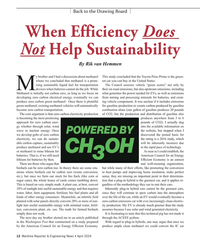 )
April 2024 - Maritime Reporter and Engineering News page: 12
)
April 2024 - Maritime Reporter and Engineering News page: 12Back to the Drawing Board When Efficiency Does Not Help Sustainability By Rik van Hemmen y brother and I had a discussion about methanol This study concluded that the Toyota Prius Prime is the green- where we concluded that methanol is a prom- est car you can buy in the United States. ising sustainable
-
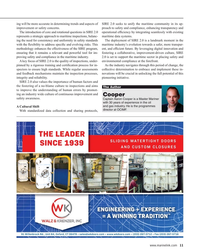 )
April 2024 - Maritime Reporter and Engineering News page: 11
)
April 2024 - Maritime Reporter and Engineering News page: 11ing will be more accurate in determining trends and aspects of SIRE 2.0 seeks to unify the maritime community in its ap- improvement or safety concerns. proach to safety and compliance, enhancing transparency and The introduction of core and rotational questions in SIRE 2.0 operational ef? ciency by
-
 )
April 2024 - Maritime Reporter and Engineering News page: 10
)
April 2024 - Maritime Reporter and Engineering News page: 10Maritime Safety © Roman/AdobeStock SIRE 2.0: Navigating the New Horizon of Maritime Safety By Captain Aaron Cooper, Programs Director, OCIMF he maritime industry is on the cusp of a signi? cant preparing vessel operators and vessel assurance teams for the transformation with the launch of the Ship
-
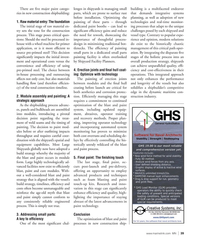 )
April 2024 - Marine News page: 39
)
April 2024 - Marine News page: 39operational costs versus the by Shipyard Facility Planners. overall production strategy, shipyards convenience and ef? ciency of using can achieve unparalleled quality, ef? - pre-primed steel. The choice between 4. Erection joints and ? nal hull coat- ciency and cost-effectiveness in their in-house processing
